This is a group of pictures of bees I’ve taken mostly in my yard and on shoots around our area. Florida has over 300 native species of bees, and there are over 500 in Georgia. Not all of them will be on this page. Instead, you’ll see the bees that may visit our yards often, along with a few that don’t come as often. I’ll keep adding as I photograph new species, or witness interesting behaviors.
You might see a picture of the type of bee you saw in your yard even if not of the exact bee you saw. Sometimes, the best we can do is identify a genus of bees, or a tribe. Some bees need several detailed photos, or a microscope, to differentiate between related species. This page organizes bees into their families. So you might be able to identify that you have a leafcutter or a sweat bee.
We’ve collected some information to help you attract bees to your home garden. You can make a home for bees by giving them plants that are good for them, a place to nest, and even water. Click here to learn more.
Carpenter bees build their nests in dead wood. In our yards, this could be fences or any other (usually unfinished) wood structures. Understandably, some people regard them as pests. If you don’t mind a few perfectly round holes in a fence post, these bugs are pollinators, and other pollinators use their nests too.
We talked to Dr. Rachel Mallinger, an assistant professor of Entomology at the University of Florida, talked about native bees that live in Florida. She also talked about carpenter bees. They do bore into wood, which concerns homeowners. Dr. Mallinger points out that carpenter bees nest in soft, usually decaying wood. Hardwood is used to build the main part of a house, while softwood is used for the trim, railings, and fences. If the main structure isn’t decaying, carpenters may nest in the softwood structures.
Carpenter bees can find another place to nest if you leave dead wood in brush piles or incorporate it into the landscape in some other way. Learn more in our post on helping nesting bees. Carpenter bee nest in an old, but very special (to my kids), stick. I put their “special sticks” together in a bundle and decorated it with other things they had found in nature over the years.
Dr. Mallinger also spoke about male carpenter bee’s tendency to fly at humans. It’s aggressive, and unsettling when they get in your face, but male carpenter bees have no stinger.
One last note about carpenter bees. They look, at first, like large bumblebees. The easiest way to differentiate between the two is the abdomen. As I tell the kids, bumblebees have fuzzy “butts,” whereas carpenter bees have smooth abdomens. There is, however, one other species of bee in the area that looks like carpenter bees and has “smooth butts.” Check it out below. ”.
Bumble Bees in Georgia – A Guide to Identification and Facts
Bumble bees are one of the most beneficial insects we have in Georgia They play a vital role in pollinating plants and crops across the state With over 20 different species of bumble bees found in Georgia, it can be tricky to identify them. This guide will provide tips on identifying the most common bumble bees in Georgia and share some fascinating facts about these essential pollinators.
When it comes to identification, size is often the first clue. Bumble bees are generally larger and fuzzier than honey bees. Their bodies are robust and rounded, often marked with distinctive bands of color like black, yellow, white, orange or even red. Bumble bees have a longer tongue than honey bees, allowing them to pollinate flowers with deeper tubes like lupines and foxgloves.
The most frequently spotted bumble bee in Georgia is the common Eastern bumble bee. These bees have a primarily black body with a lemon-yellow band on the front of the thorax and another yellow band at the end of the abdomen. The queens of this species can grow up to 2 cm long. You’ll see these bees busily buzzing from flower to flower, even in cloudy and cool weather when other bees stay home.
Another bumble bee to look out for is the brown-belted bumble bee. These handsome pollinators have a striking pattern of one yellow band in the middle and a brown band at the end of their mostly black bodies. They love foraging on lavender, blueberries, and other native plants.
The yellowbanded bumble bee is aptly named for its two distinct yellow bands. These bands stand out brightly against the black background. This species forms small colonies compared to other bumble bees.
Part of what makes bumble bees excellent pollinators is their furry bodies that easily pick up and carry pollen as they fly from bloom to bloom. Bumble bees also perform a behavior called “buzz pollination” where they vibrate rapidly to dislodge pollen from flowers. Plants like tomatoes, peppers, and eggplants benefit greatly from buzz pollination.
Beyond pollination, bumble bees are fascinating creatures. Did you know that only queen bumble bees survive the winter? The queens that emerge in early spring have the big job of founding new nests and raising the first worker bees. Bumble bee colonies live for just one season, usually dying out in the fall, except for newly fertilized queens.
Understanding the common bumble bees in our state and appreciating their role as prolific pollinators will help us support these threatened insects. Simple actions like planting native flowers, leaving areas of long grass, and avoiding pesticides can make a difference for bumble bee populations in Georgia. Watch for them visiting your garden this season!
Western honeybee (Apis Mellifera)
Because they aren’t native, I saved these for last in this family. They are an important farm animal, though. Below is the most common honeybee we might see, the female worker bee. They do many things during the weeks they are alive, from taking care of larvae to looking for nectar to bring back to the hive and turn into honey.
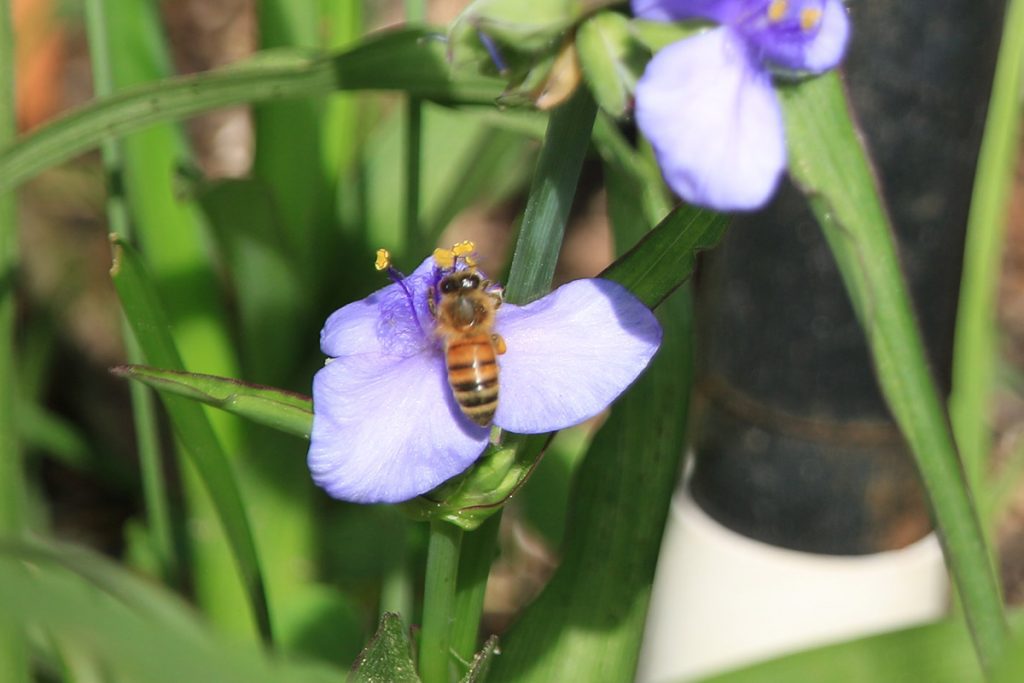
Below are the queen, the mother of all of the bees in the hive, and a drone. In order to tell them apart from female bees, drones have bigger eyes that help them see a queen bee flying. Their only job is to find a queen and mate.

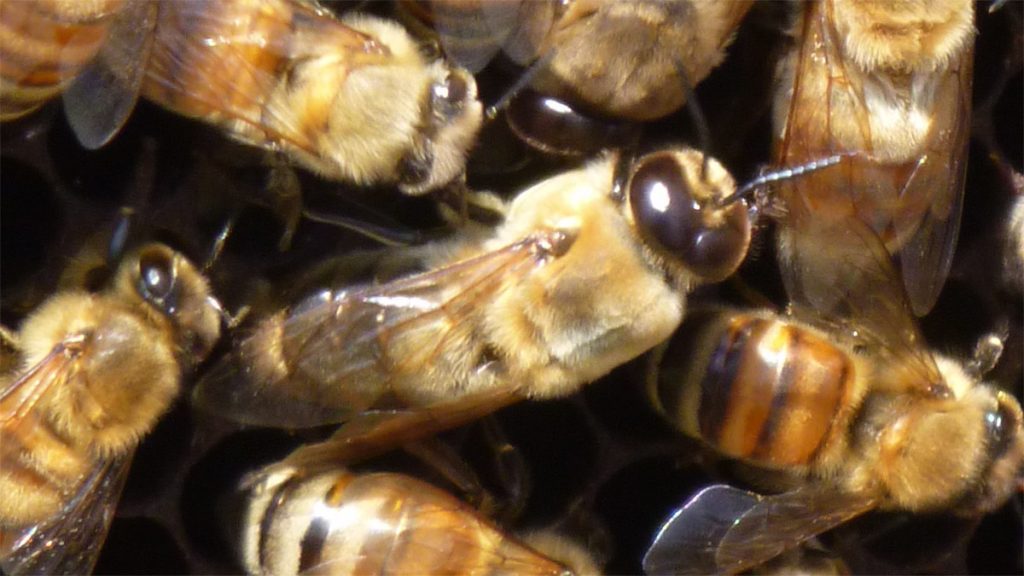
Honeybees build hexagonal cells in their hives. Some of those cells contain honey, and others larvae. Worker bees take care of the larvae until they are almost ready to pupate, which means they are almost ready to change into adults. The cells are then sealed off. You can see larvae in the uncapped cells below.
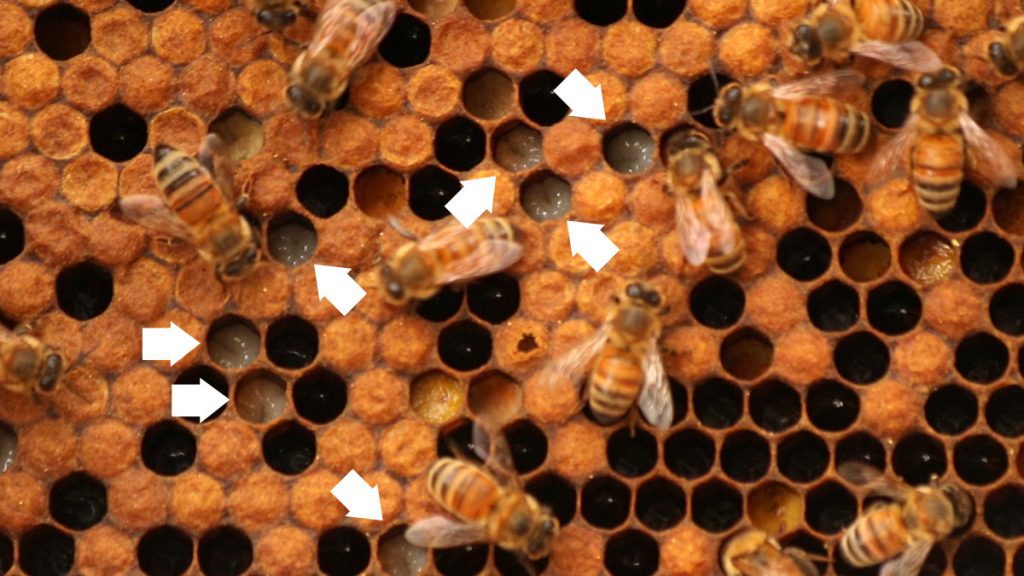

Leafcutter, mason, and resin bees
This is a family of solitary nesting bees with similar habits. They use tunnels that have already been dug, like those left by wood-boring beetles or bugs that dig holes in the ground. Leaf cutters will, as their name suggests, cut leaves to line these tunnels and build their nests. Mason bees collect sediment to seal their tunnels, much like mason wasps. Resin bees use resin to seal their nests.
With its smooth abdomen and yellow hair, the male carpenter-mimic leafcutter looks much like a smaller carpenter bee. Note the narrower wing shape and flatter abdomen, and the shape of the head compared to the carpenter. The female mimics the female southern carpenter bee, with an all-black body and less hair than the male.
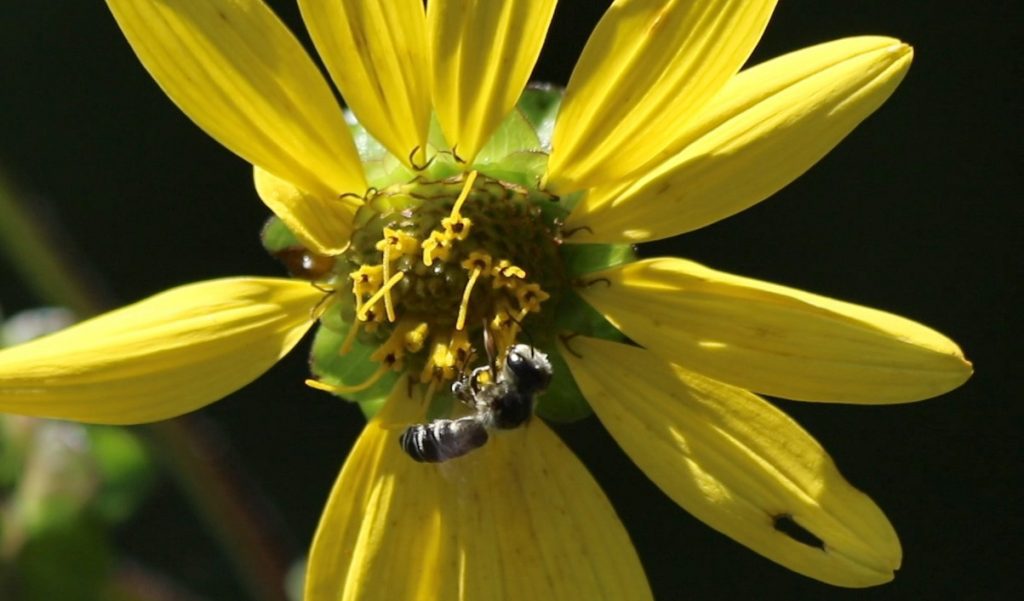
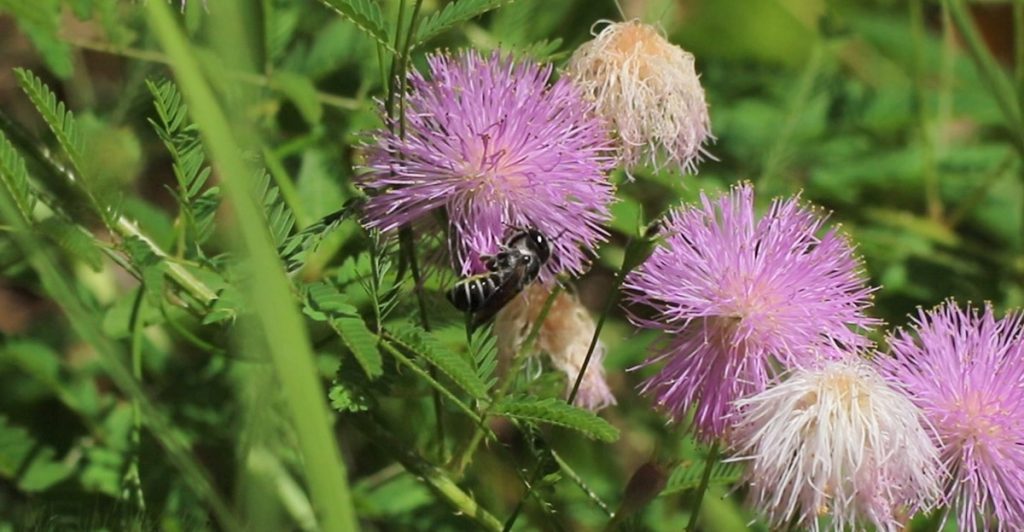
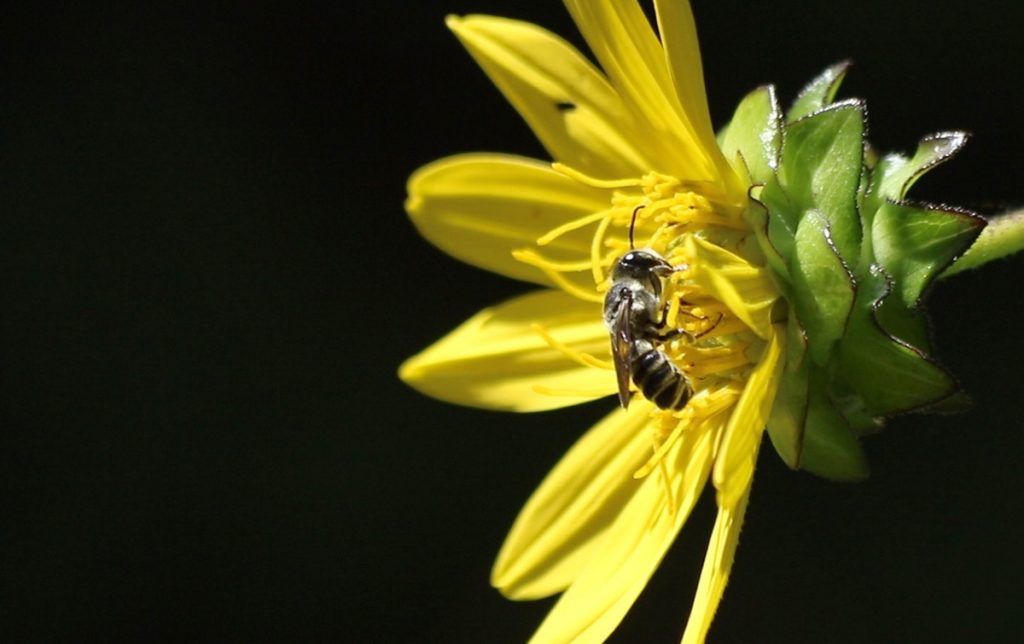
This is another species of leafcutter I spotted while shooting video in Klapp-Phipps Park in Tallahassee. I couldn’t narrow the ID to anything more specific than genus, which isn’t uncommon for bees. This subgenus of Megachile does not make their nests with leaves, but rather with plant resins. So this is considered a mason bee.
A bee in this subgenus briefly visited our yard in May of 2023. iNaturalist identified it as a Megachile campanulae bellflower resin bee, a species of bee that is rarely seen in Florida and not in Leon County. No one has confirmed it, and this was the only time I saw it in the yard. If I see it again, maybe a few photos taken from different angles will help ID it. A resin bee in the genus Megachile, subgenus Chelostomoides.
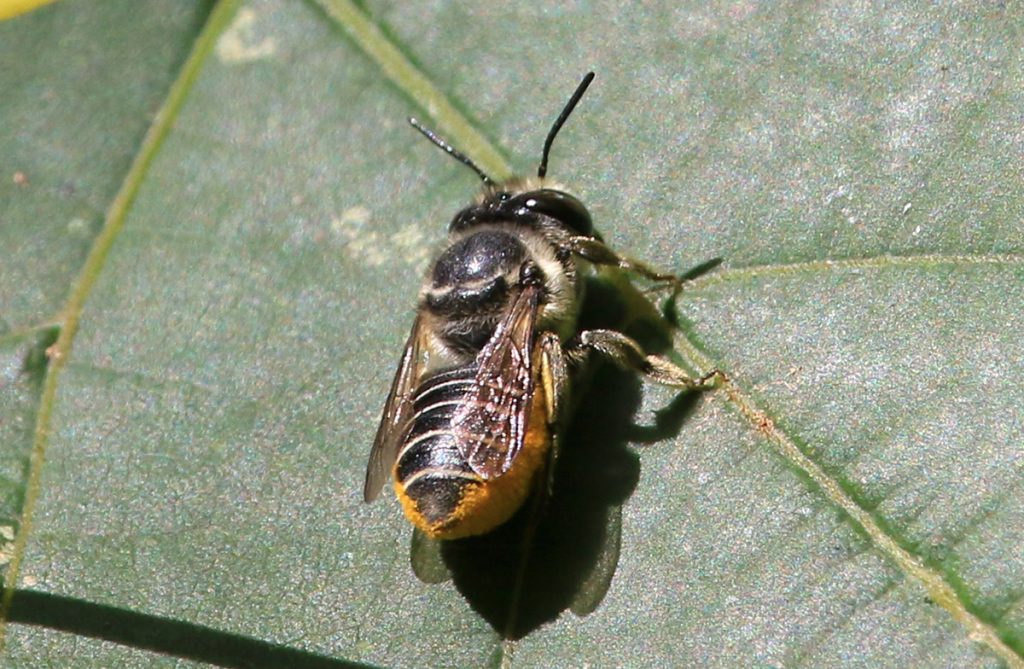
Here are two very similar-looking leafcutters. The s above and below were taken at Klapp-Phipps Park on two different dates. At first, I thought they were both flat-tailed leafcutter bees. After loading the s into iNaturalist, it appears they might be two different species. Bee researcher Dr. John Ascher from the National University of Singapore is very active on iNaturalist. He suggested that the bee above be called petulant leafcutter.
Dr. Ascher confirmed flat-tailed leafcutter (Megachile mendica) for the below, which was taken in my yard. From pictures of the bees on Google and their Discover Life pages, it looks like the differences between flat-tailed and petulant leafcutters are very technical. It might be too technical for me to learn about in the time I have to write this post, but I promise I’ll keep coming back to these pages with new photos and any new information I understand. Flat-tailed leafcutter bee (Megachile mendica).
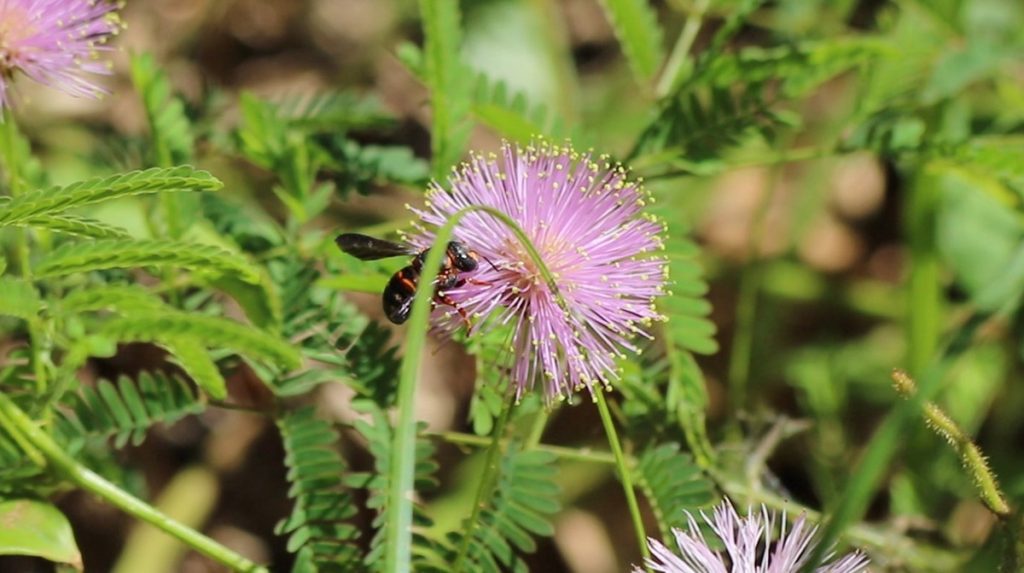
I have only one of this bee, from a patch of sensitive plants at Klapp-Phipps.
There are different families of cuckoo bees in the Apidae family, listed above. This cuckoo bee is in the Megachilidae family, which means it is genetically a leafcutter, even though it reproduces more like other cuckoo bees that are less closely related. Like other bees and wasps labeled “cuckoo,” this is a kleptoparasite.
Sharp-tailed bees kleptoparasitize other leafcutter species. Cut leaf pieces are used by leafcutters to make nests. Coelioxys breaks into these nests with her sharp tail, killing the eggs in a few cells and putting her own eggs there instead. I started seeing this bee in the yard when it started attracting more leafcutters. They’re often on flowers near to those used by other leafcutters.
Note the lack of pollen sacs, or the pollen-collecting hairs we see under the abdomens of other leafcutters. Because cuckoo bees don’t ned to stock their own nests, they do not need to collect pollen. Cuckoo leafcutter bee (Genus Coelioxys) in the Munson Sandhills region of the Apalachicola National Forest.

This is a large and diverse family of bees. Sweat bees are among the tiniest bees that we see on flowers. They range in size from gnat-sized Dialictus bees to bigger and more colorful Augochlorini bees. They are said to be attracted to human sweat.
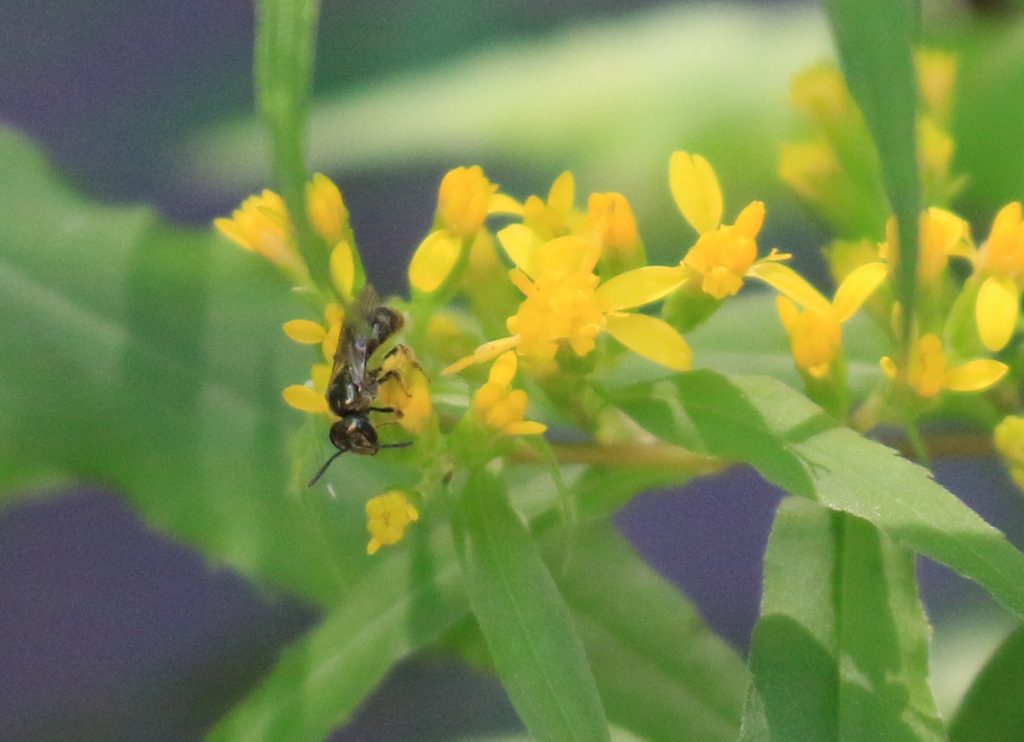
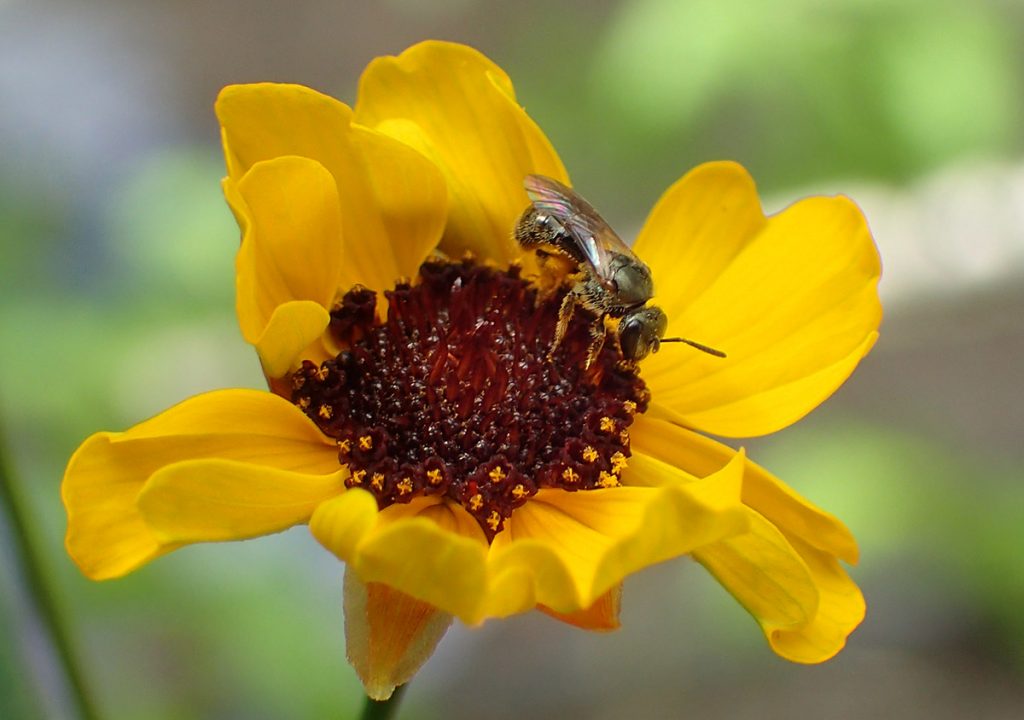
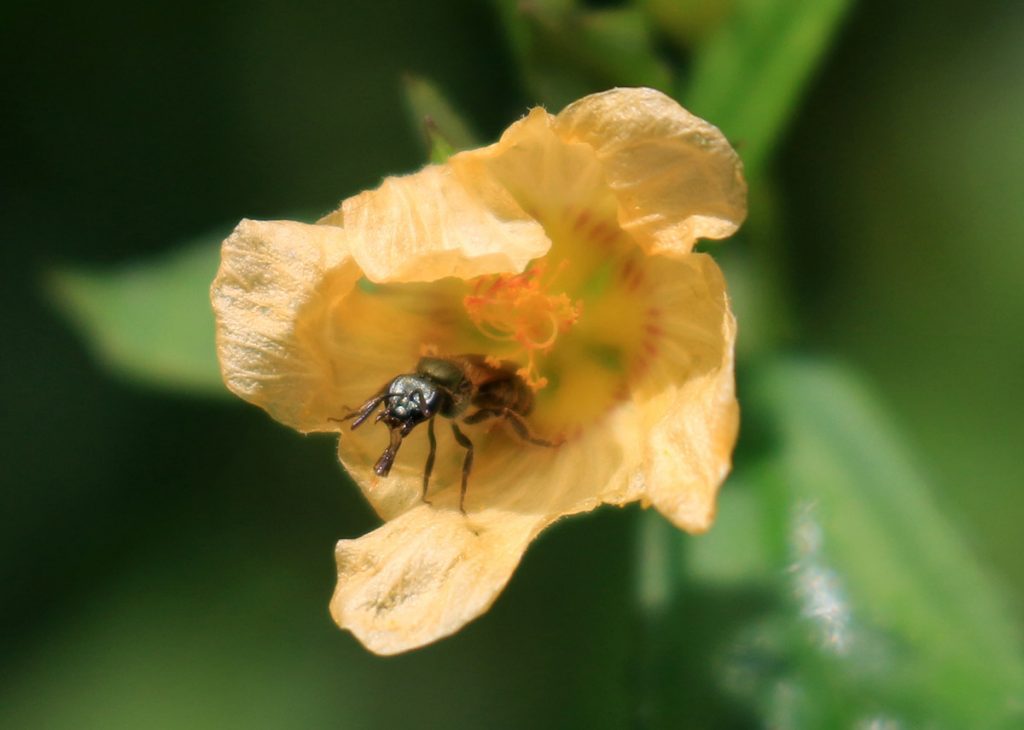
Dialictus is a subgenus of the Lasioglossum genus, and it has hundreds of very similar-looking bees. They are difficult to differentiate, even with a microscope. I see quite a few in my yard, and some are slightly larger than others. I figure, based on size, that I have at least two species. Or maybe it’s the same species but the males or females are bigger? Dialictus sweat bee on a tiny yellow woodsorrel flower
Here’s a Lasioglossum, subgenus Dialictus, bee for which I actually received a species-level identification. It looked not quite like a Poey’s furrow bee, and not quite like other Dialictus. This is a southeastern bee, which, according to its bugguide page, flies from March to November in most of its range, and year-round in Florida.
In 2023, I made an effort to photograph as many small bees in our yard as possible. Here is a second species-level identification for a Dialictus sweat bee.
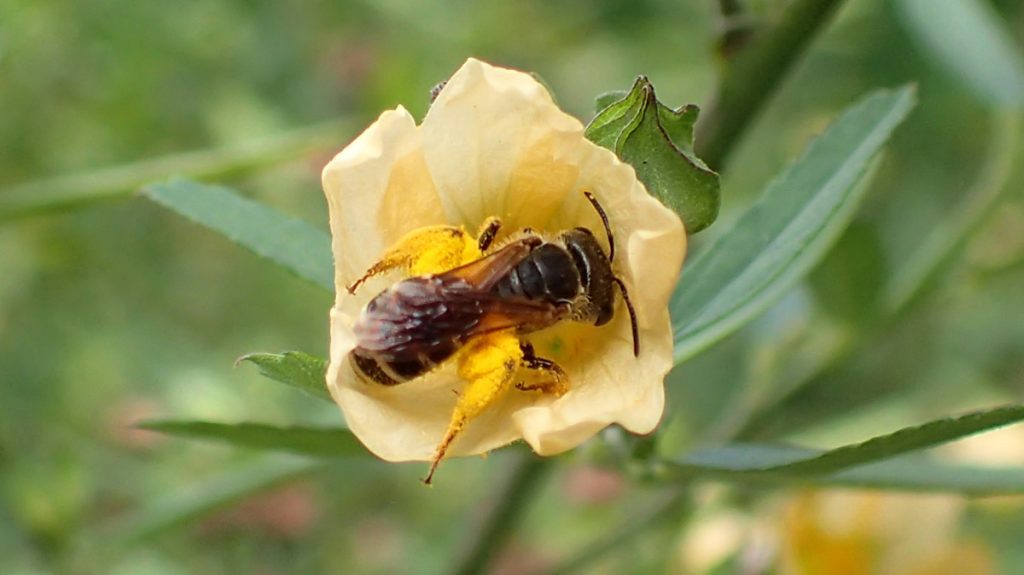
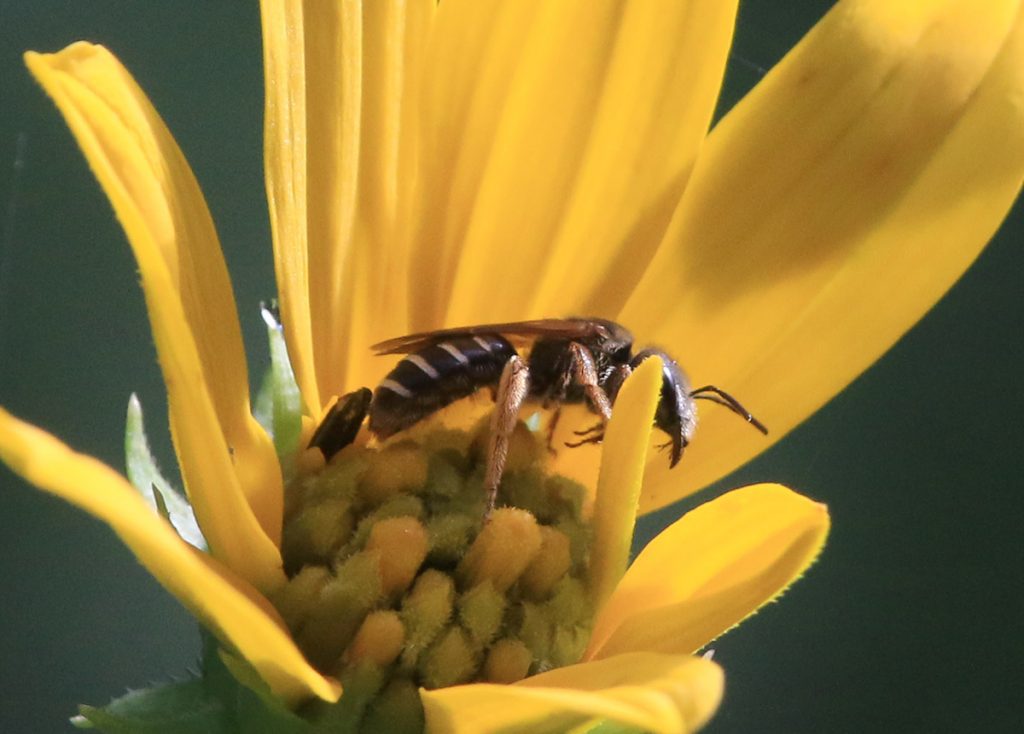
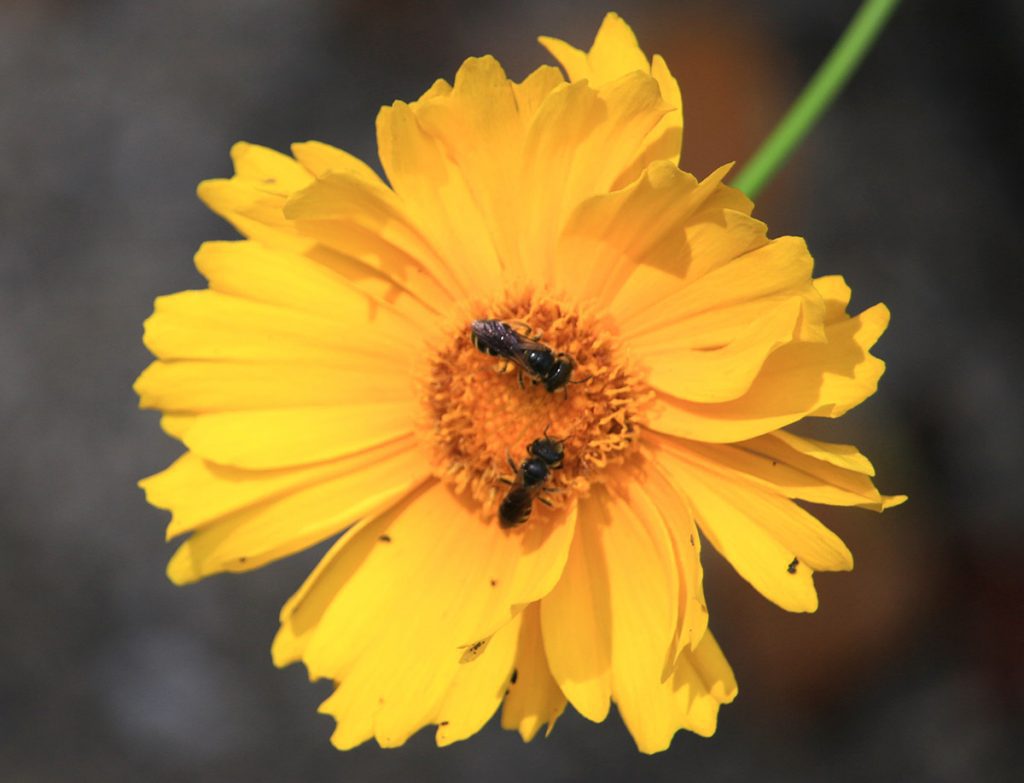
The largest Dialictus bee in our yard is about the same size as a Poey’s furrow bee, and they often eat the same flowers. The furrow bees have a more pronounced yellow and black striping on the abdomens, and big, thick heads. These small bees are common in north Florida yards and parks.
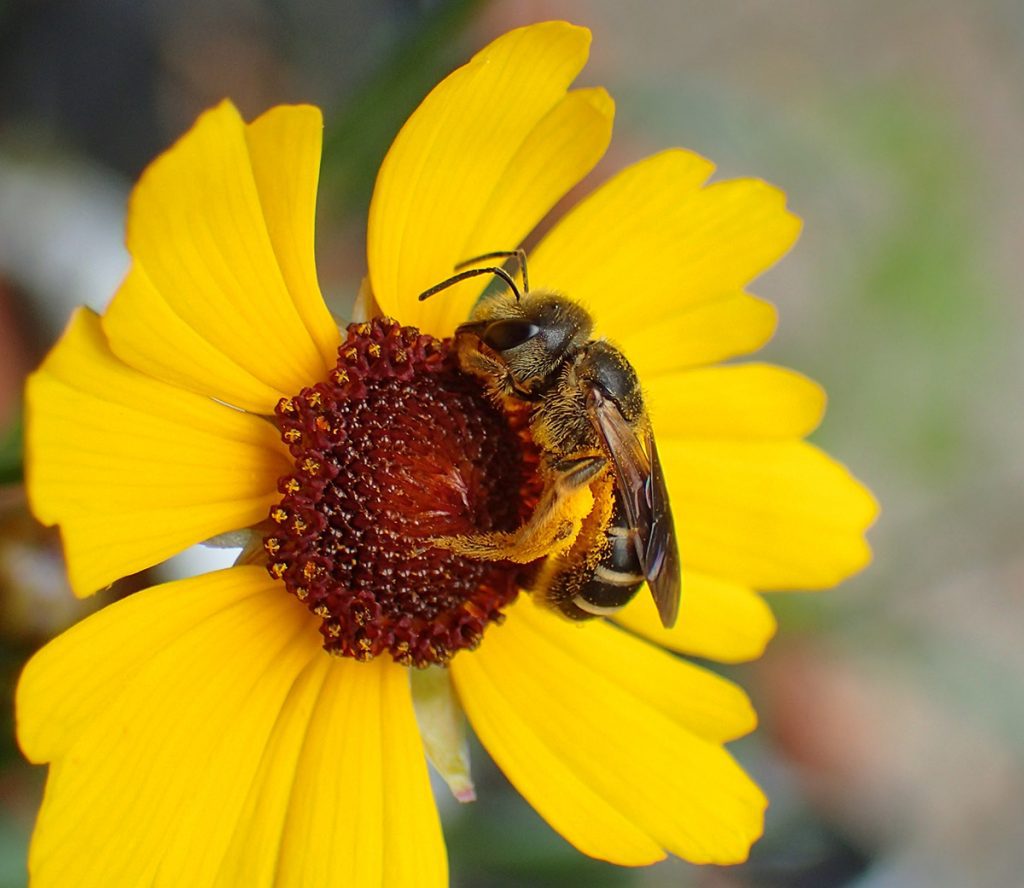
Above is the female Poey’s furrow bee. In 2022, I saw a male for the first time when one attempted to mate with a female. Poey furrow bees mating.
You can see the female, left, has a larger and less hair-covered head. Also, like most bee species, the female gathers pollen to bring back to the nest, but the male can’t do that. This picture was taken in the fall, when furrow bees stop flying and the females look for a place to stay warm. Before doing so, they mate, and the female carries the next year’s brood within her. In the spring, she’ll emerge and make a nest. Male Poey’s furrow bee on Georgia aster, November 2022. Note the small, hair-covered head, and the relative lack of pollen on his body.
The two or three species we’re most likely to see in our area look a lot alike. Augochlorine bees are solitary nesters.
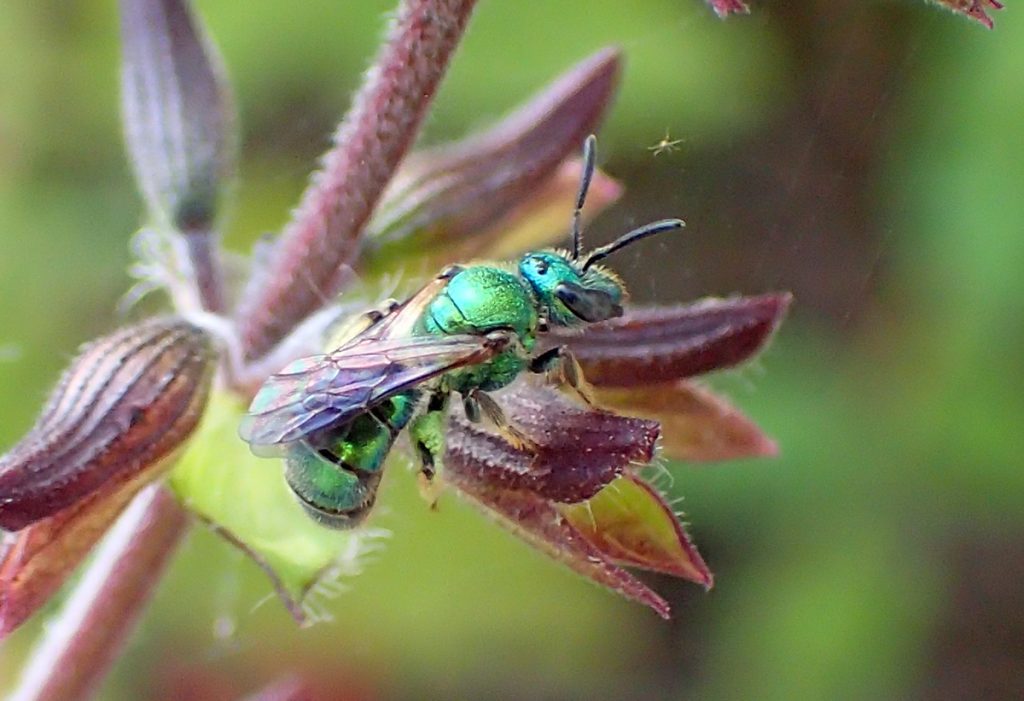
The photo above was submitted to iNaturalist and confirmed to be a pure green sweat bee (Augochlora pura). Another possibility in our area is the metallic-epauletted sweat bee (Augochloropsis metallica).
Below are a few photos of Augochlorine sweat bees. I’m noticing that very few get species-level confirmations on iNaturalist. One of the bees below is a deep blue color, but that’s a normal difference in color for these bees. They also look a lot like the next bee we’ll look at, the female brown-winged striped-sweat bee, but that bee is easier to tell apart because it has a few unique traits.
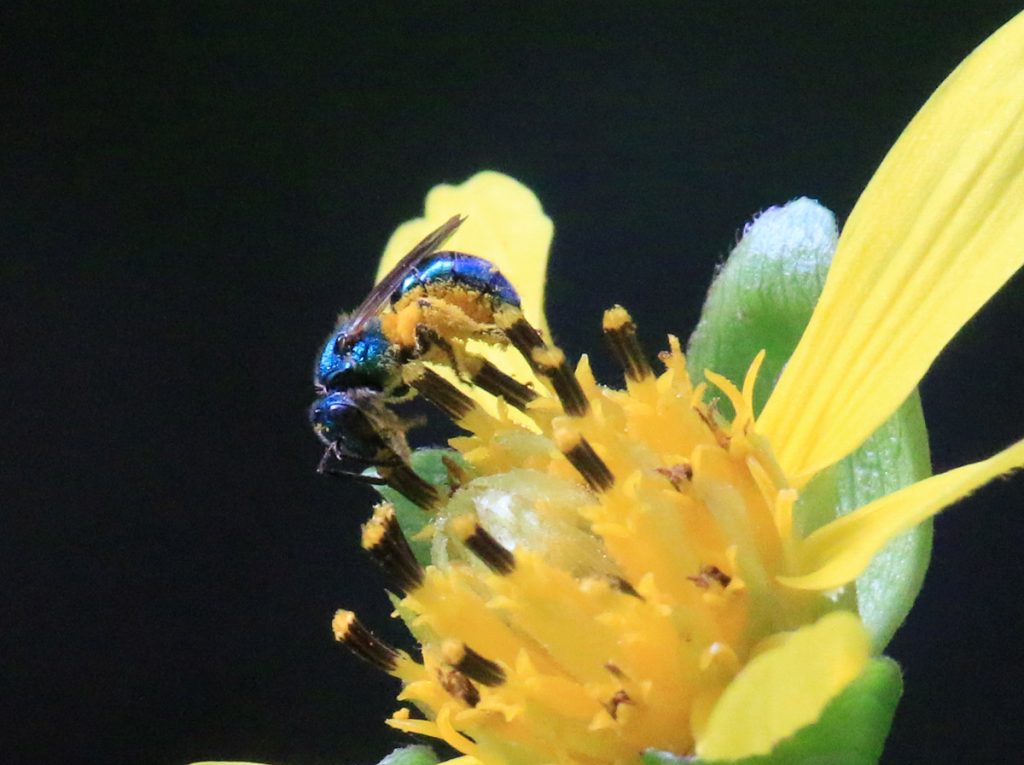
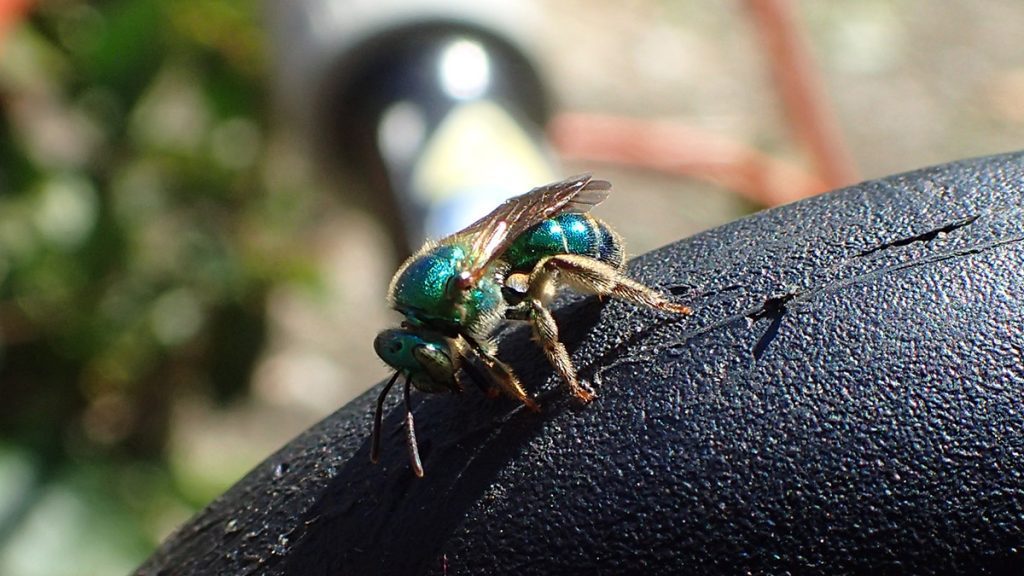
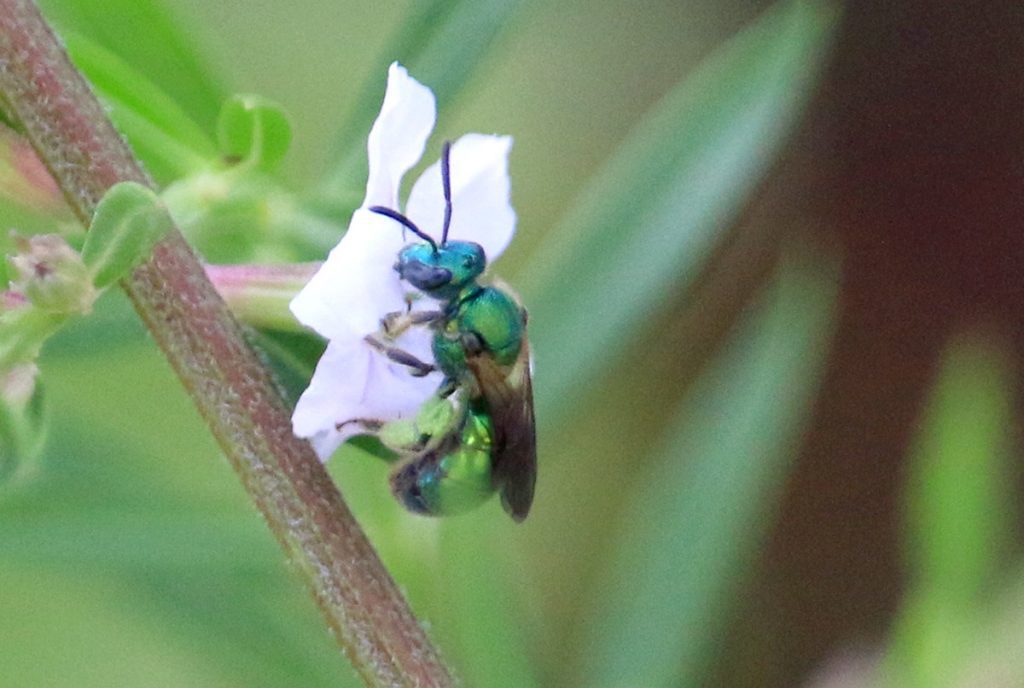
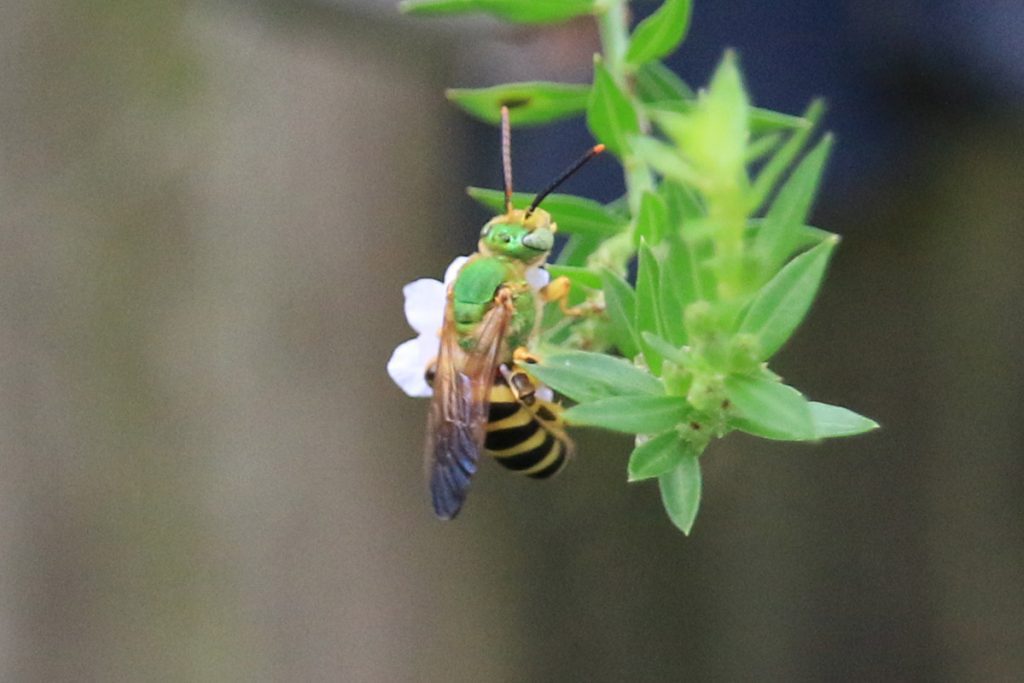
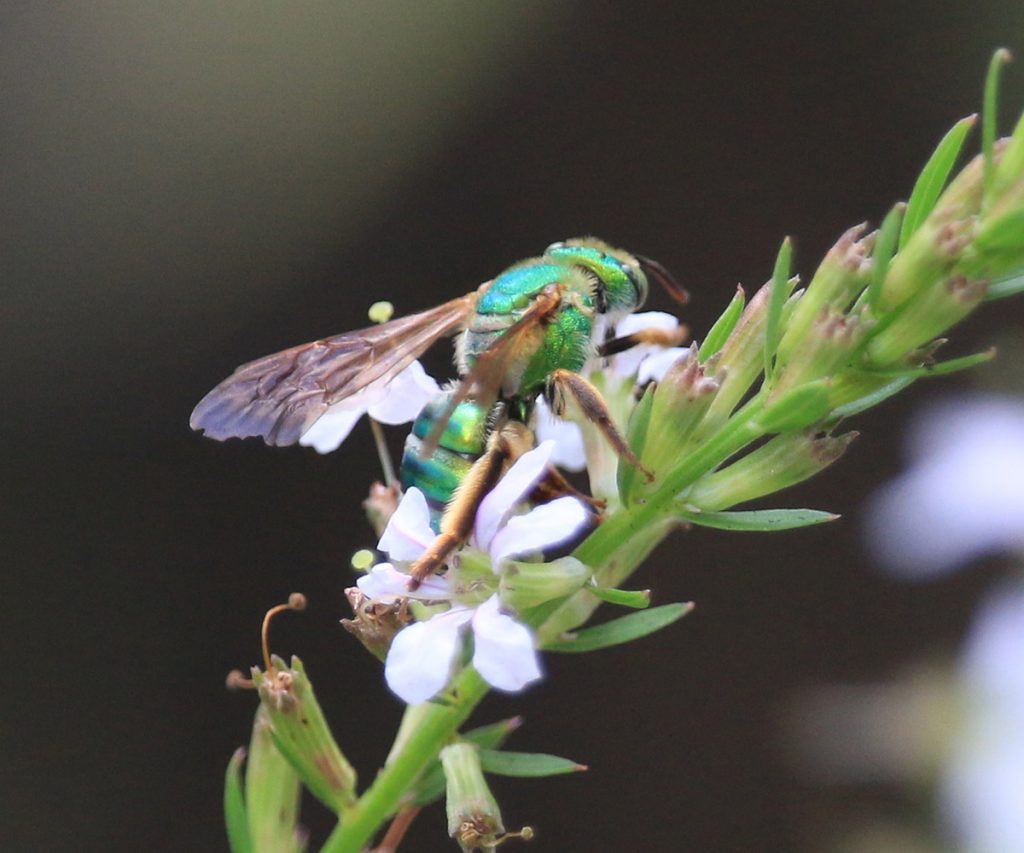
The male brown-winged striped sweat bee is unmistakable. I saw more and more of the males on flower patches in our yard in August 2019 and 2020. I saw females, which have a similar green coloring to the Augochlorine bees, as early as June 2020. Since then, the start of the population explosion has been a couple of weeks off each year. It usually happens when dotted horsemint blooms in late summer.
One subtle difference between Agapostemon and Augochlorine bees is the wings. Female brown-winged striped sweat bees have murkier wings than Augochlorine bees. Scroll up to see the picture of the pure green sweat bee. Its wings look more like they’re made of glass. Another difference is that the female brown-winged striped sweat bee has more pronounced stripes on its abdomen:
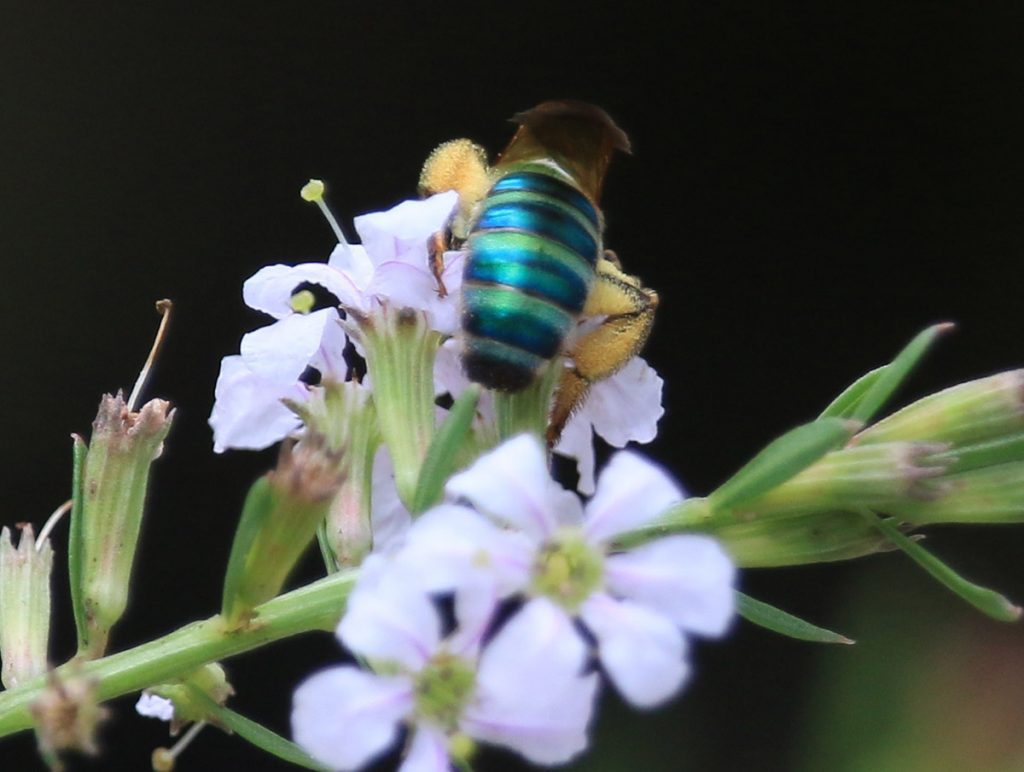
Sweat bees are ground nesters, though they may also nest in rotting wood. In July 2019, I took down an old wooden bench in the yard. A green sweat bee flew out of the ground. I followed it as it appeared to search the ground for a new nesting area. If you have a brush pile in your yard or a place to put a big branch that has fallen and wants to rot, this is one of the insects that would like to live there.
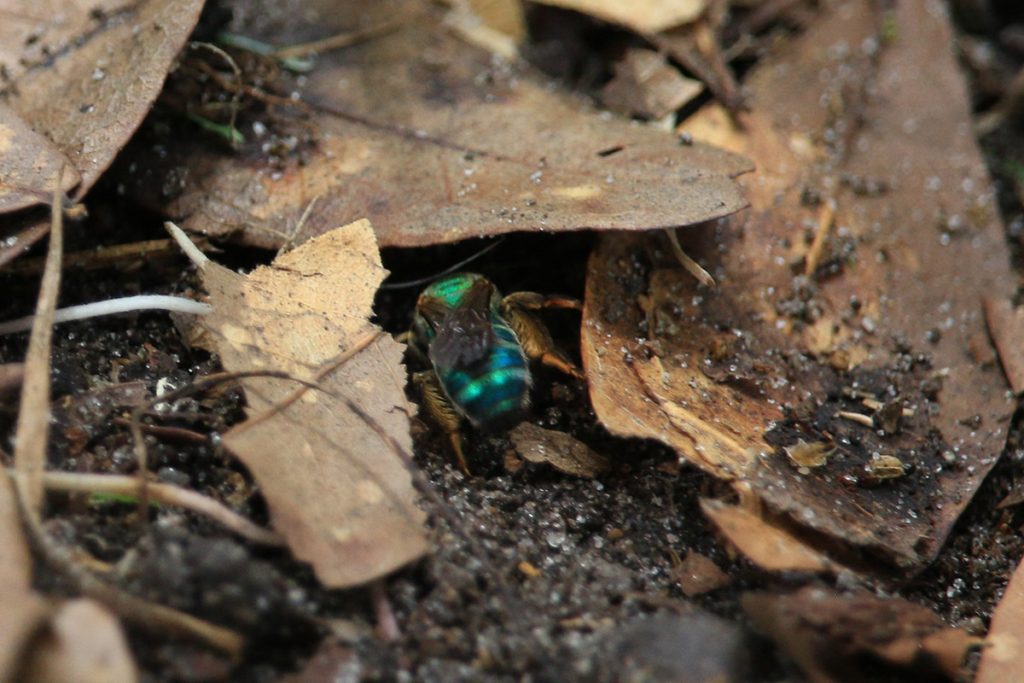

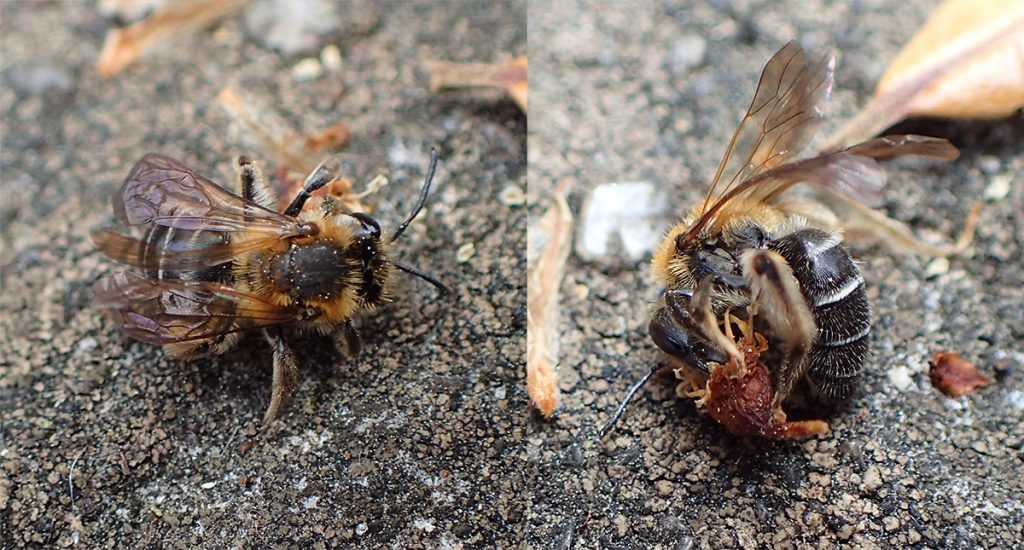
Mining bees are early fliers that get their food from flowering trees like Carolina cherry laurels, which bloom in late winter or early spring.
I saw this bee one time in my yard, tackling some shriveled flowers on the pavement. Dr. Ascher suggested the subgenus Archiandrena in iNaturalist.
In April 2021, I saw a few mining bees going back to their old nests or digging new ones under strewn-out leaves in open ground. Although mining bees often nest close together, sometimes in the hundreds, they are solitary nesters. They do not form hives together; social, hive-building bees and wasps are generally more aggressive than solitary nesters. Mining bee in the genus Andrena, returning to its nest, which is concealed by a fallen leaf.
Here’s a bee I first spotted in March of 2023. I’d been watching honeybees visit dewberry flowers, when I noticed a couple of darker bees. They looked like mining bees, but in our yard, I’d only seen those on tree flowers. This is a Barbara’s mining bee.
It has brighter, yellowish hair compared to other Andrena, but I’ll keep an eye out for further iNaturalist suggestions for this bee. According to its bugguide page, it is often overlooked and misidentified. Barbara’s mining bee (Andrena barbara) on dewberry flower.
There is a group of small mining bees in the mining bee family, and within that group is a group of fairy and goblin bees called the Perditina. The bees in the picture above are fairy bees in the genus Perdita. I thought they were small Lasioglossum sweat bees. Fairy bee (Perdita genus) on a silkgrass flower.
It can be hard to tell one fairy bee from another, just like it is hard to tell one small Lasioglossum sweat bee from another. Contrast this bee the fairy bees directly above it on this page. It has a few colorful features – stripes, and a green mouth. Also, note the lack of pollen sacks. This is a male.
This bee was in the Munson Sandhills when I took a picture of it and posted it on iNaturalist, where the site’s top bee curator, Dr. John Ascher identified it. It’s the only time I’ve seen this tiny bee, and when I looked for more information, I didn’t find much. This, to me, is the joy of photographing insects and using iNaturalist. The sheer number of insects in the world makes it so that many of them are little understood. This includes insects you may see in your yard. If you take the time to see them, take a picture of them, and share that picture somewhere where researchers can see it and know where you found it, you are giving them valuable visual information that can help us learn more about the insect and the place where it lives.

Plasterer- aka polyester- bees
Cellophane Bees (Colletes genus)
Plasterer bees are solitary ground nesters that line their nests with a secretion that resembles cellophane. The substance is a natural polyester, and so plasterer bees are also called polyester bees.
Cellophane bees are a genus of bees (Colletes) in the plasterer bee family (Colletidae). The above hasn’t yet gotten a species-level identification in iNaturalist. The sandhills cellophane bee is a likely candidate because I saw this one in a sandhill habitat. This species is one of two Colletes species that have been seen in the Florida panhandle.
It looks like this is a long-faced cellophane bee (Colletes longifacies), according to a report by Dr. John Ascher. This central/ north Florida endemic, he says, is “Historically overlooked due to late flight season. ” As Dr. Ascher notes, Colletes longifacies is a “rarely recorded, localized, and specialized species. ” It has previously been recorded on clusterleaf blazingstar, a fall-blooming wildflower. Long-faced cellophane bee (Colletes longifacies) on a blazingstar flower in the Munson Sandhills.
I saw this bee on March 1, 2023, on a cherry laurel tree overhanging our yard. According to bugguide.net, this bee flies in January and February in Florida. Based on this observation, though, I’d say that as close to Georgia as Tallahassee is, that here the bee flies a little bit into March. Rufous-backed cellophane bee (Colletes thoracicus) on cherry laurel flower.
This bee was first described in 2016, and it has only been seen in a few places in north Florida and one place in Mississippi. People don’t see the bee very often because it only flies for a short time and stays in one place.
It has only been seen a few times on or near blueberry bushes, mostly in sandhill habitats near cypress wetland areas. Climbing fetterbush, a plant related to blueberries, grows on cypress trees, and blueberry bushes do well near the ponds. Ground-nesting bees can’t dig in that sand because it’s too wet. This bee needs deep, open sand to build a nest. A nesting site for the sandhills cellophane bee in the Apalachicola National Forest. There are abundant blueberry bushes between a cypress-lined lake and a sandhill with open sandy areas.
Blueberries in north Florida bloom in February and March, and that’s when you would see this bee flying. Males also fly in December, making it one of the few native bees in the air in winter. The best way to find the bees themselves is to find their nests on sandhills. They are about three inches across and have a hole that is about one centimeter wide (yes, I used both metric and standard units). If you see the bee, you can add your observations and photos to iNaturalist to help researchers keep track of the species. Sandhills cellophane bee nesting burrows.
Many of the photos above come from the Backyard Blog. Since 2018, WFSU Ecology producer Rob Diaz de Villegas has been keeping a record of the animals and plants in his yard. He pays special attention to the bugs.
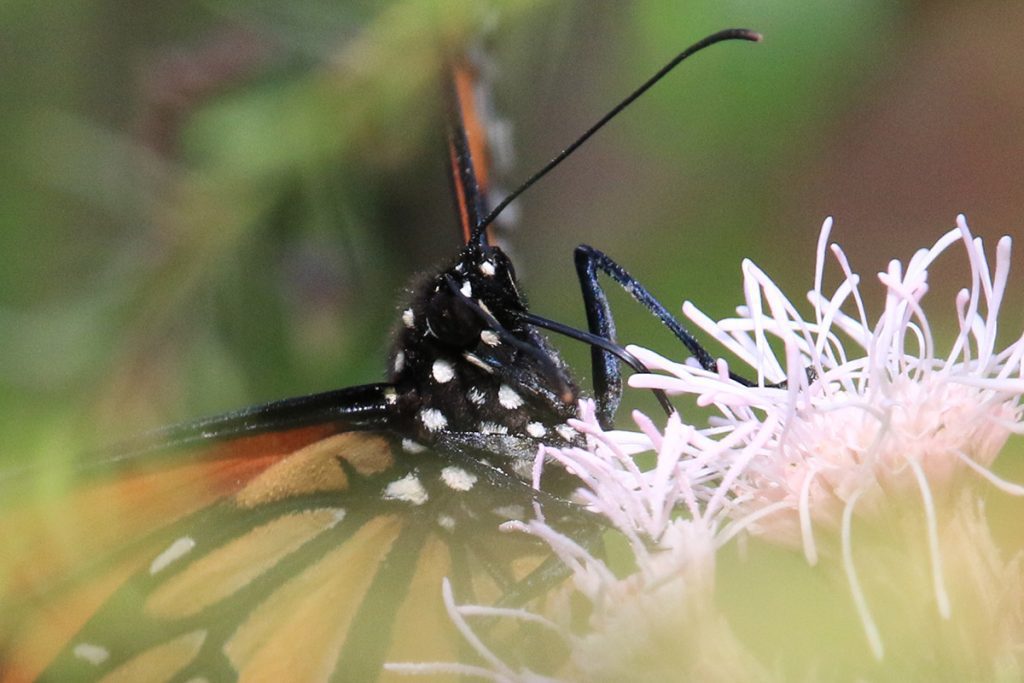
Is there anything we can do to get butterflies, birds, and other animals to come into our yards? What about the weeds, bugs, and other animals that already live there? The WFSU Ecology Blog takes a closer look.
If you do not receive a verification e-mail, check your spam folder.
Bees! | Georgia Outdoors
FAQ
Are there bumble bees in Georgia?
What month are bumble bees most active?
Is it good to have bumblebees in your yard?
Do Georgia bumble bees sting?
Where are bumble bees found?
Bumble bees are distributed worldwide, with up to 260 species all over the globe. Most species are encountered in the northern hemisphere, while others are located in central and southern America and northern Africa. Forty-nine bumble bee species in the United States are known, and 17 of them are found in Georgia.
What is a two spotted bumble bee?
The Two-spotted Bumble Bee (Bombus bimaculatus) is a social bumble bee that can be encountered in Georgia. These bees have two yellow spots on the abdomen. They are excellent pollinators, foraging on a wide variety of plants. There is the only size that differentiates the queen from the workers.
Are bumble bees endangered?
The American Bumble Bee (Bombus pensylvanicus) is a threatened species, native to North America. The population has dropped by ninety percent in the past twenty years. These bees live and nest in open farmlands and fields, feeding on food plants, including clovers and sunflowers.
Are bumble bees good pollinators?
Bumble bees are greatly valued as pollinators of native and nonnative plants, including ornamentals, and cultivated plants, such as blueberries. Due to their body morphology and behavior, bumble bees are particularly efficient in pollinating certain economically important crops, such as tomatoes, cranberry, cucumber, and watermelon.
Are bumble bees dangerous?
However, commercially produced bumble bees have been implicated in spreading pathogens, causing serious diseases to native bumble bee populations. Bumble bees interact with several plants by obtaining their nutrition from pollen and nectar.
Why are bumble bees important?
Bumble bees are important pollinators of many plants in landscapes and specialty crops. They forage and pollinate many wildflowers and native plants, maintaining diversity in native plant communities as they coevolve with certain native plants.
